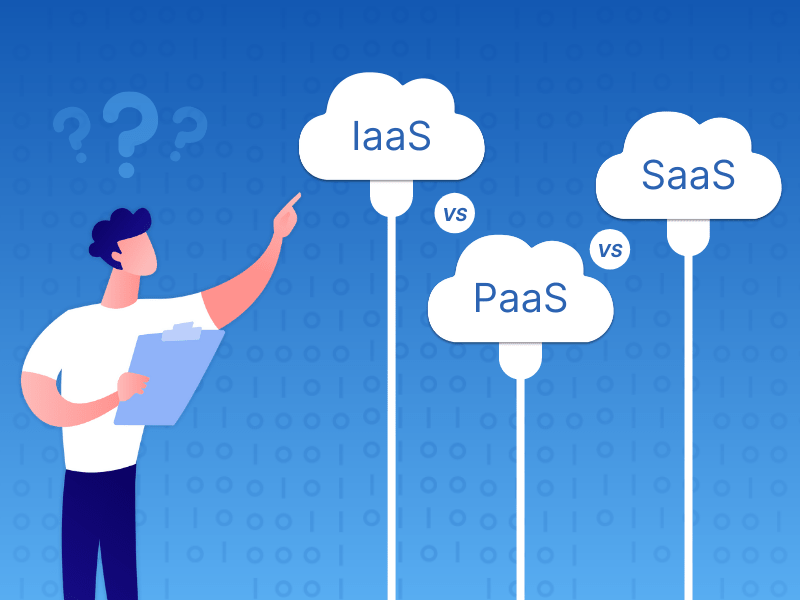IaaS vs. PaaS vs. SaaS: Explaining the Key Differences
The shift towards cloud computing has revolutionized how businesses operate and manage their IT infrastructure. Within the cloud computing ecosystem, three popular models dominate the landscape: Infrastructure as a Service (IaaS), Platform as a Service (PaaS), and Software as a Service (SaaS). While they all offer cloud-based solutions, understanding the critical differences between these models is crucial for businesses to make informed decisions about their technology needs.
Cloud computing has become an integral part of the modern digital landscape. It allows businesses to efficiently manage their IT infrastructure without substantial investments in hardware, maintenance, and software licenses. However, it is essential to understand the differences between IaaS, PaaS, and SaaS to determine the best fit for specific needs.
Infrastructure as a Service (IaaS)
IaaS is the most fundamental cloud computing model. It provides virtualized computing resources over the Internet. In IaaS, businesses rent the hardware and infrastructure to host and manage their applications. This includes servers, storage, networking, and virtualization capabilities.
The critical advantage of IaaS is its scalability and flexibility. Businesses have complete control over the infrastructure, allowing them to quickly scale up or down based on their requirements. Leading providers of IaaS include Amazon Web Services (AWS), Microsoft Azure, and Google Cloud Platform.
However, deploying applications in IaaS requires technical expertise, as businesses are responsible for managing and maintaining the infrastructure. This makes IaaS more suitable for companies looking for complete control and customization of their IT environment.
Platform as a Service (PaaS)
PaaS takes the cloud computing model further by providing a platform for application development and deployment. It offers the necessary tools, frameworks, and runtime environments to streamline the development process and simplify the deployment of applications.
With PaaS, businesses no longer need to worry about managing the underlying infrastructure. The platform handles scaling, load balancing, and server management, allowing developers to focus solely on coding. Examples of PaaS providers include Heroku, Google App Engine, and Microsoft Azure.
The critical advantage of PaaS is its ease of use and developer-friendly approach. It significantly reduces the time and effort required to set up an application infrastructure from scratch. However, the downside is reduced control and customization compared to IaaS.
Software as a Service (SaaS)
SaaS is the most user-centric cloud computing model. It offers ready-to-use software applications over the Internet. Users can access these applications through web browsers or dedicated client applications without installation or maintenance.
SaaS providers handle all the infrastructure, development, and maintenance aspects. Users subscribe to the service, and the software is available at their fingertips. Famous examples of SaaS providers include Salesforce, Dropbox, and Microsoft 365.
The main advantage of SaaS is its convenience and accessibility. Users can access applications from anywhere, and the provider automatically applies updates and bug fixes. However, SaaS limits customization and may not be suitable for businesses with unique requirements.
Comparison and Differences between IaaS, PaaS, and SaaS
While all three cloud computing models offer various benefits, they differ significantly in infrastructure, development, and software.
Infrastructure: IaaS provides complete control over infrastructure, PaaS manages the underlying infrastructure, and SaaS offers ready-to-use applications.
Development: IaaS requires businesses to manage and deploy their applications, PaaS provides tools and frameworks to streamline development, and SaaS eliminates the need for application development.
Software: IaaS offers infrastructure, but software installation and management are the responsibility of the business. PaaS provides the entire development platform, but applications must be built on top of it. SaaS delivers fully functional software applications out of the box.
IaaS offers the most control regarding flexibility and scalability, followed by PaaS and then SaaS. Cost considerations vary depending on the model and usage patterns.
Businesses must consider the specific needs of their operations and IT requirements when choosing between IaaS, PaaS, and SaaS. The suitability of each model may vary depending on the industry and application.
FAQs
FAQ 1: What is the main difference between IaaS and PaaS?
IaaS provides the underlying infrastructure, while PaaS offers an application development and deployment platform. With IaaS, businesses have complete control over the infrastructure, whereas PaaS takes care of the infrastructure management, allowing developers to focus on coding.
FAQ 2: Can a business use all three models simultaneously?
Yes, businesses can leverage all three cloud computing models simultaneously. They can choose IaaS for their infrastructure needs, utilize PaaS for streamlined development, and subscribe to SaaS applications for specific software requirements.
FAQ 3: Are there any security concerns with these cloud models?
Security concerns exist in cloud computing, regardless of the model chosen. However, reputable cloud service providers invest heavily in security measures, including data encryption, access controls, and regular audits. Businesses must select trusted providers and implement additional security measures as needed.
FAQ 4: How can I determine the best model for my business?
To determine your business’s best cloud computing model, consider your specific requirements, technical expertise, and budget. Assess your need for control, customization, scalability, and development resources. Consulting with experts or conducting a thorough analysis can help you make an informed decision.
FAQ 5: Can I switch between these models once I have chosen one?
In most cases, it is possible to switch between cloud computing models. However, it requires planning, migration strategies, and potential adjustments to the architecture. It’s advisable to consult with experts and plan the transition carefully to minimize disruptions and ensure a smooth transfer of services.
Conclusion
In conclusion, understanding the critical differences between IaaS, PaaS, and SaaS is essential for businesses embracing cloud computing. Each model offers unique advantages and disadvantages, providing companies with options to align their technology strategy with their needs. Whether it’s the complete control of IaaS, the developer focus of PaaS, or the user-centric approach of SaaS, cloud computing models continue to shape the future of IT infrastructure.
READ MORE: PHP vs ASP.NET: Which is Better?





